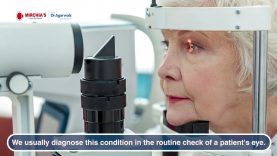What is Posterior Vitreous Detachment or PVD? What are the symptoms of PVD? How can it be prevented?
- 56
- No date provided
Dr. Anin Sethi
Dr. Anin Sethi
What is Posterior Vitreous Detachment or PVD? What are the symptoms of PVD? How can it be prevented?
In tis video, SimpliHealth expert Dr. Anin Sethi talks about PVD, the Posterior Vitreous Detachment, its symptoms, treatment and prevention.
What is PVD?
Old-aged patients must have heard that they have abnormal jelly or jelly starts to crumble outside; or they have been diagnosed with PVD. So PVD is not a life-threatening disease. Instead, it is an age-related change. It’s one among age-related problems. The eye consists of a jelly-like substance called vitreous, which helps maintain the eye’s size. It is attached to the eye’s retina and is present at the backside of the eye. So this jelly is connected to the retina in many places.
Is PVD age related?
With respect to age, there is a change in the protein composition of jelly, and it starts liquifying. It crumbles from the retina during liquefaction or starts detaching itself from the retina. After a certain amount of liquefaction, the jelly completely detaches itself from the retina, so this condition is called Posterior Vitreous Detachment.
What Are The Symptoms Of PVD?
The main symptom of PVD is the occurrence of floaters. The patients with floaters tend to see tiny shadows roaming in the air; the second thing they may experience is flashes of light, also called photopsia. The patient may suddenly see a flash of light from any corner, but these light flashes are painless and last for only a few seconds.
These two are the main symptoms, and the third thing is, however, scarce, but a patient may see a curtain in front of the eye. But it is significantly less and occurs mainly in severe cases.
PVD leads to what type of changes in the eye?
When this jelly crumbles from the retina, some protein releases further roaming at the back of the eye, casting its shadow in front of the retina, leading to the floater’s condition. The second thing is that the jelly might be very tightly attached to the retina in some places, so this crumbling, causes strain in the retina, which leads to the formation of flashes of light, or they suffer photopsia. The third thing, since its attachment is substantial, when it crumbles, the piece of the retina may come outside along with the vitreous.
The vitreous crumbling might lead to the formation of tears in the retina, which further leads to the crumbling of retina or retinal detachment.
What is in incidence of PVD?
PVD is a natural age-related problem, and it affects 60 % of old-age people within the age group of 60 years. With the advancement of age, its incidence increases. If the patient is more than 80 years old, then there is a 100% probability that they are suffering from PVD.
Not all patients get the same symptoms of PVD. We usually diagnose this condition in the routine check of a patient’s eye. PVD may affect smaller age groups like myopic patients with enlarged eyes and negative lens power of more than 3.5-4.5. PVD may occur as a side effect of various eye operations like cataracts or glaucoma.
Therefore, it may affect any age group. Laser operation of the retina in diabetic retinopathy where there is hemorrhage in the eyes so all these conditions may induce PVD irrespective of age. Diabetic patients are at more risk of PVD or any injury to the eye may lead to PVD at a young age.
Bottom Line
To conclude, if you are above 60 years of age and observe symptoms like floaters or flashes of light, or there is an additional shadow in the eye, it is most susceptible that you have PVD. Therefore, we need to visit our ophthalmologist for its treatment, which will dilate the eye by putting medicine and will examine the retina for any casualties caused by PVD like holes in the retina or a chance of retina detachment or bleeding.
The occurrence of such conditions, however, is improbable to occur. But, still, the doctor will screen the retina. We hope this information is beneficial to you.















Comments (0)